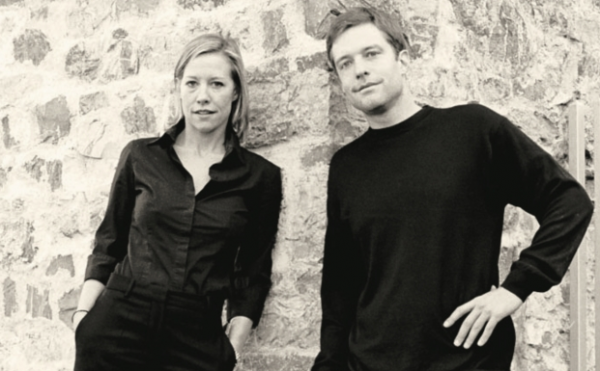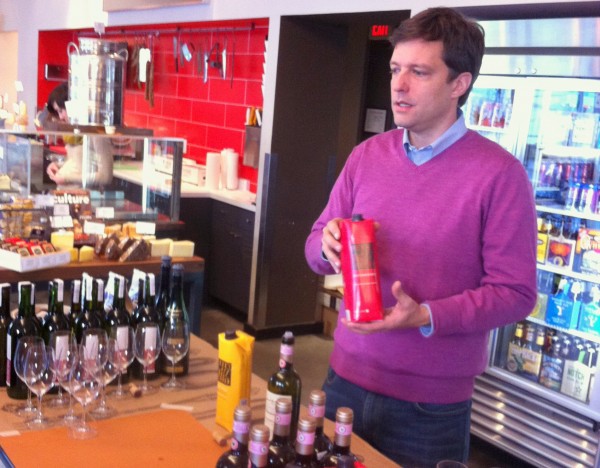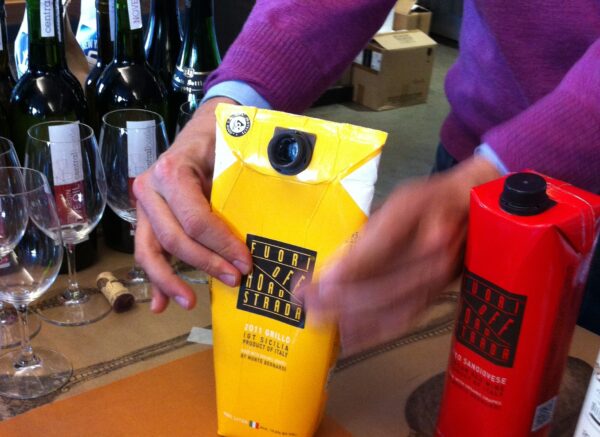 Michael Schmelzer is the enologist and agronomist at Monte Bernardi, his family’s wine estate in Tuscany. The 130 acre property is in Panzano, the very heart of Chianti Classico (it’s said that the dead center – the ‘bellybutton’ – of the region runs through the property). Schmelzer, 38, lives on the property with his wife Claudia, daughters Olivia (7) and Sabina (3), Dad, and sister Jennifer (with him above) who is responsible for the family’s business affairs and according to her brother is “the backbone of the operation.”
Michael Schmelzer is the enologist and agronomist at Monte Bernardi, his family’s wine estate in Tuscany. The 130 acre property is in Panzano, the very heart of Chianti Classico (it’s said that the dead center – the ‘bellybutton’ – of the region runs through the property). Schmelzer, 38, lives on the property with his wife Claudia, daughters Olivia (7) and Sabina (3), Dad, and sister Jennifer (with him above) who is responsible for the family’s business affairs and according to her brother is “the backbone of the operation.”
Schmelzer dropped by Central Bottle last week to pour three of his wines (we couldn’t be more enthusiastic about them) and talk about what makes his property a special one. What follows is an edited version of my chat with him.
How does an American come to be making wine in Tuscany?
My father worked in the automotive industry and my family lived in Europe for extended periods. When the time came for my parents to retire, they and my sister hatched a scheme to bring the family together on a beautiful estate and make wine together. By then, I had graduated from enology school and they had confidence that I could make good wine. We had to balance my mother and sister’s desire to live in a beautiful place with my desire to make great wine.
We looked in lots places, including Languedoc and Piedmont. It took two years to find Monte Bernardi and I knew right away this was the place because it had everything. It was a working winery and there was olive production. It was in good condition. We saw places in France that were larger for the same price and places in Barbaresco that were smaller for the same investment. Monte Bernardi seemed just right. It has some of the highest altitudes, steepest slopes and rockiest soils in the region. We’ve been there for 11 years now.
What do the neighbors think?
Fortunately, wine people are hospitable. Many of the properties around had people my age making the wine and they were especially welcoming. We hosted a lot of winemaker dinners. It’s kind of amazing but only one producer in Panzano is actually a native of the region. They’re Italian, but they come from Turin or Naples, not Tuscany. So in one sense we’re all in the same boat – almost none of us are locals!

Your formal education in enology occurred in Australia. How did that prepare you to make wine in Italy?
It was really important that I went there to learn winemaking. In Australia I had all this exposure to wines made in a place where there was really no history and no culture of winemaking. The long European experience with winemaking doesn’t exist there. I got to taste lots of things from the same area and it gave me the impression that New World wines lack the history and tradition Europeans take for granted. When I finished there I had a strong desire to make a wine that could only be made in one place. I didn’t want to make an international wine, I wanted to make a wine that spoke of the place it came from, one that couldn’t easily be transported and made somewhere else.
So you know the kind of wine you don’t want to make. What are you after at Monte Bernardi?
For me the most important thing as a producer is to make things as simple as possible. I look at everything I learned in enology school as techniques that strip wine [of its character]. The only real piece of technology I have in our winery is a peristaltic pump. When I think about the tools that are in the enologist’s tool kit, they should be very simple – the basics. In a different place I might need other technology, but not here.

In Chianti we have rocky soils and a big day/night temperature differential and I wanted to make something that reflects these local conditions. Every decision I make at Monte Bernardi is designed to emphasize locality. We have this unique piece of land with unique geologic features. It’s my job to see that each parcel receives its best expression, whatever that may be, then blend them together to make the best wine I possibly can. I use very little new oak. I prefer to get my tannins from grapes.
I love my neighbors, but I think they go against their own natural advantage if they use barriques [small oak barrels] and non-native grape varieties. If I were in a different place, I might arrive at other conclusions.
You’ve called Tuscany “the Bordeaux of Italy.” Why?
Because Tuscany, like Bordeaux, is full of enologists and enologists need to justify their existence by complicating winemaking. In Tuscany almost every property has a consulting enologist but not even half, I would guess, have a consulting agronomist! Italy has its own wine culture. In the past it was taken for granted, maybe not put on a pedestal as in France. Italy can and should rely on its own history. They shouldn’t shy away from what they learned by trial and error. The knowledge still exists in the experience of pensioners, old farmers who remember the way things used to be done, the ones who did the vineyard work. It produced very good results.
You farm organically and practice a modified biodynamics. What aspects of Steinerism don’t suit you?
Biodynamics and what I call ‘old farming’ have a lot in common, but some aspects ofbiodynamics didn’t work for us. A lot of the Steiner ideas are theoretical and not practical. For example, if I only picked on flower days I wouldn’t be able to get the harvest done in time. Old farmers didn’t have the luxury [of observing a biodynamic calendar].

Why is some of your traditionally-made wine is put into non-traditional packaging?
You don’t really go into this business with the idea of making money, but with more experience we realized that our economic model with a mean bottle price of around 9 euros wasn’t going to be sustainable. We didn’t see a business model that would carry us into the future. So rather than opting to buy wine in and increase our production, we decided to be the first to bring into the U.S. organic Italian wine in Tetra Pak.
We learned that 90% of all wine consumed in the U.S. is consumed in 24 hours and that the recycle rate for glass bottles is only about 26%. We think Tetra Pak is going to be big – it takes away a lot of the cost associated with bottles. One printed Tetra Pak has about the same cost as one cork. We transport the wine in bulk Buffalo, N.Y. where it’s packaged.
You can make 5 Tetra Paks for the same energy a bottle requires. But we’ didn’t opt for the new packaging based on the ecological advantage – although it’s a big one. We use them because we can sell what would be $25 bottle of wine for $17.
This is the thing that will make it a successful package. I could have put cheaper wine into Tetra Pak and offered them at an even lower price. But because Americans don’t really have any expectations for the quality of wine that comes in this packaging, we decided to leverage the cost advantages to bring a higher quality wine to consumers at a lower price.
Our quality goals are no different for wines packaged this way. We reduced the costs, but the savings aren’t being taken out of the wine.
* * * *
Tasting Notes
2011 Monte Bernardi “Fuoristrada” IGT Sicilia. 100% grillo from grapes grown in Sicily. Attractive pale gold hue. A surprisingly sizeable, flavorful wine that’s dry and savory with a bit of grip a lingering finish. 1 liter Tetra Pak; vegan certified. $17.
2011 Monte Bernardi “Fuoristrada” IGT Toscana. 100% sangiovese from purchased grapes. Deep, garnet-mahogany. Pleasing aromas of acid, dirt, black cherry; big, rich mouthful of sourish black cherry fruit and lots of loamy earth. Bit rustic – but delicious. In a bottle, this would be labeled Chianti Classico. 1 liter Tetra Pak; vegan certified. $17.
2010 Monte Bernardi “Retromarcia” Chianti Classico. 100% sangiovese from estate fruit. Medium deep garnet with mahogany tints; forest, spruce, balsalmic, and soy sauce aromas. Lovely burst of black cherry-like fruit on the palate; solid acid structure, fine zip and freshness, too. Long, satisfying finish. 750ml bottle, $26.
Reach me at stephenmeuse@icloud.com
Follow Stephen Meuse